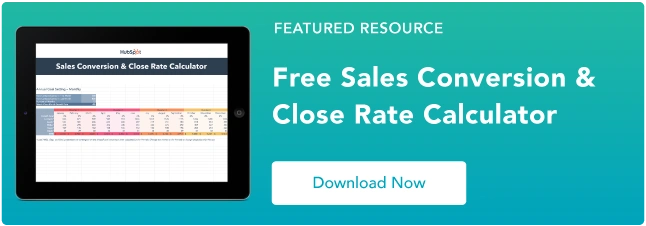In this guide, I’ll walk you through how to forecast sales and which forecasting models are available. I’ve also talked with other experts to gain insights into data-driven sales forecasting and forecasting accuracy.
Ready? Let’s dive into it.
Table of Contents
- What is Sales Forecasting?
- Why Sales Forecasting is Important
- Common Sales Forecasting Challenges
- Sales Forecasting Best Practices
- Sales Forecasting Template
- Factors That Can Impact Your Sales Forecast
- How to Forecast Sales
- Sales Forecasting Methods
What is a Sales Forecast?
A sales forecast is a prediction of what sales will be for a set time in the future. The best sales forecasts are in-depth reports that include metrics for what a salesperson, team, or company will likely sell weekly, monthly, quarterly, or annually.
Most sales forecasts draw from historical sales data and take demand fluctuations into account. While these can be created manually, most firms use some type of sales forecasting software to help automate the task.
Why Sales Forecasting is Important
The goal of sales forecasting is to provide you with information that you can use to make informed business decisions. Sales forecasts impact financial planning, sales targets, marketing strategies, and even staffing.
I’ve seen sales organizations without detailed forecasts, or with sloppy forecasts, file for bankruptcy when their cash flow predictions failed. Some had to lay off a huge chunk of their staff just to remain operational.
Let’s go over some of the main benefits of a sales forecast:
- Boosts motivation. A sales forecast is a powerful motivational tool. For example, I update my forecasts quarterly and compare them to my team’s progress. If the team is crushing it, we can celebrate and acknowledge high performers.
- Highlights potential issues. With sales forecasting, my team and I have been able to spot potential issues early, giving us enough time to avoid or mitigate them with new sales strategies.
- Hiring and resource management. Forecasting allows informed decisions regarding hiring and resource management. For example, if my forecast predicts a 70% uptick in holiday demand, I might need to hire seasonal staff and order production supplies early.
- Investment planning. Having a strong sales forecast helps plan your cash flow. If I have good data on my cash flows, I can better plan for investments without overextending and know when I might need a cash infusion from a loan.
- Enables investor relationships. I’ve seen firsthand how forecasting future sales can help you forge partnerships with potential investors. Investors and other stakeholders will want to see if your company can provide a return on investment, and detailed sales forecasts as part of a strong business plan help justify sales revenue estimates.
Common Sales Forecasting Challenges
-1.webp?width=650&height=411&name=challenges%20(2)-1.webp)
While sales forecasting offers many benefits, it also comes with its own set of challenges, such as an inaccurate pipeline.
“It can be very difficult to forecast if deals in the pipeline do not have accurate ARRs assigned to them or if they are at the wrong stage,” says Daniel Harding, director of Australian operations at MaxContactAustralia, a customer engagement software platform.
Other challenges include:
- Lack of sales history. If you’re a new business or a startup, you won’t have much past performance data to work with, which can make it difficult to forecast sales accurately. That said, you can use sales data from industry benchmarks and market research to create initial forecasts.
- Inaccurate data. If the data used to create revenue estimates is inaccurate or imperfect, your sales forecasts will also be inaccurate.
- Lack of collaboration. A lack of collaboration between sales and other departments, such as marketing and finance, can lead to inaccurate sales projections.
- Seller subjectivity. Relying on your salesforce’s gut feelings and emotions rather than objective data will result in inaccuracies.
- Technology limitations.Businesses use an average of 10 tools to close a sale, but often there’s no integration, making it challenging to gather all the information needed to produce accurate forecasts.
Sales Forecasting Best Practices

I’ve developed a set of sales forecasting best practices over the years. These best practices help me stay consistent and produce accurate forecasts for sales planning.
Use technology like AI.
Implementing AI in sales forecasting can help your sales reps close more deals. AI gets a lot of negative press for bad art and poorly written text, but it’s an effective sales forecasting tool. According to a HubSpot report, 85% of salespeople using AI reported that it makes their prospecting efforts more effective.
You can also use AI to analyze customer sentiment (how people feel about your brand) and incorporate this data into your forecasts.
Review and update forecasts regularly.
You should review and update your forecast regularly to ensure it remains accurate. After all, things like market trends and economic conditions are subject to change. How frequently you do so depends on your industry, but we recommend reviewing your forecasts at least once every month.
Account for internal and external factors.
Internal and external factors like policy changes and economic conditions can influence your forecasts. If you create a forecast in a vacuum without accounting for company policies and market conditions, the forecast will fail.
Sales Forecasting Template

There’s a common theme throughout sales forecasting methods: Data.
Byron Goodman, head of sales at marketing automation provider Customer.io agrees. “Always focus on the data. If you can’t see the deals, take a look at historic trends to determine if a similar situation has occurred before.”
It’s worth noting that even the most lightweight forecasting options rely on knowing how many opportunities are in each rep's pipeline and the likelihood of the project closing. That’s why we created our free Excel template.
It includes:
- A dropoff and conversion rate calculator.
- A deal and MRR pipeline tracker.
- A template for setting monthly and quarterly sales goals.
You can also automate the process with a free CRM from HubSpot. With it, you can track your actual and predicted revenue and automatically log every interaction (email, calls, and social media), making your ability to gauge the likelihood of a deal closing even more accurate.
Factors That Can Impact Your Sales Forecast
I mentioned the need to consider how internal and external factors can influence the accuracy of a sales forecast. Let’s take a look into some of the most common factors that impact sales forecasting.
Hires and Fires
When reps leave your company voluntarily or are terminated, revenue will decrease unless you have a pipeline of potential hires. Conversely, a large increase in reps joining the company in a short time should increase your sales forecast after a reasonable training period.
Policy Changes
Company policy changes also impact your forecast. For instance, if you introduce a policy where discounts end after the 15th of each month, you’ll likely see a shift in higher close rates in the first two weeks of the month, followed by fewer sales than normal.
Territory Shifts
If your company enters a new territory, it can take time for the sales reps to get familiar with the area and build their pipelines. Likewise, if a rep moves to a different established territory it will take time to settle in. Your forecast should reflect an expected dip in closing rates to account for those changes.
Competitive Changes
Whatever the competition is doing will impact your win rate. For example, if they slash their prices, introduce a new product, or ramp up their marketing efforts, your reps may need to discount more aggressively or risk losing business.
Market Changes
If there are supply chain disruptions, raw material shortages, or even new discoveries of raw material, it affects everything from the bottom up. Market changes significantly impact your sales performance and should also be included in your forecasts.
Likewise, market changes for your customers also affect your bottom line. Tom Snyder, founder and managing partner of Funnel Clarity, a sales consulting and training company, says, “If there’s a shock to the market your buyer is in, it will certainly affect how your prospect views a buying decision.”
Economic Conditions
The state of the economy often has a large effect on your forecasts. Upswings and downturns both have impacts. Whether it’s a recession, inflation, or bull market, it will change the spending power of your clients and their comfort level with investments.
Legislative Changes
New laws and mandates can either help or hurt your business. Sometimes, they create demand for your product, such as security software sales improving after a mandate for stronger customer data security. Likewise, new regulations for emissions controls could make prospects reluctant to buy equipment that may need modifications soon to be in compliance.
Product Changes
I’ve also seen how product changes can impact a business’s sales forecasts. These changes could be rolling out a highly requested feature or removing a feature that doesn’t live up to expectations. Your team members can leverage these changes to shorten their sales cycle and close more deals.
Seasonality
Some items have seasonal demands based on the nature of the product. Others might be in higher demand due to holidays or because your customers are more likely to be taking vacation at certain times of the year. Sales forecasts should account for seasonal swings in demand.
How to Forecast Sales
-1.webp?width=650&height=395&name=howto%20(1)-1.webp)
Guided by my sales forecasting best practices, I use the following steps when creating forecasts to ensure an accurate sales forecast.
1. Document your sales process.
The first thing you need to do is document your sales process. Think about it. If your team doesn’t use the same stages, steps, and definitions, how will you be able to predict the likelihood of an opportunity closing and repeat the success? I set out guidelines for my team for how to determine what step of the sales funnel leads are in, including when they enter and exit the funnel.
Creating a documented sales process is explained in-depth in our guide.
2. Set goals and quotas.
Next, you’ll need to set goals and quotas for individual sales reps and the team as a whole. This will give your team a definition of success and a baseline to make your forecasts.
You can use data from your CRM to set your quotas. Be sure to gather data on how your team performed weekly, monthly, quarterly, and annually to discover trends.
3. Invest in a customer relationship management (CRM) tool.
Investing in a CRM can go a long way in helping you predict future revenue growth accurately. That’s because it gives you complete visibility into your pipeline. As Snyder says, “Momentum during a sales cycle is built by the buyers’ actions, not the sellers’ actions. Therefore, sales stages and forecasting milestones must be based on buyer actions.”
A CRM system also allows sales managers to assess the performance of individual reps.
I recommend using one even if your business is new.
There are many CRMs in the market, but HubSpot CRM is my favorite. It allows sales managers to track sales activity in real time. And the best part? It’s 100% free.
4. Choose the right sales forecasting method.
There are many sales forecasting methods available, and it’s essential to choose one that aligns well with your business model. You’ll need to consider things like the age of your business, your budget, size of your sales team, and the amount of available data before proceeding with a forecasting method.
I’m covering the six most popular sales forecasting methods a little further down to help you choose the best one for your business.
5. Include data from other departments.
While understanding past sales data is critical for creating a viable sales forecast, I’ve found that other departments can also provide data you can incorporate into your sales forecasts. Working with other departments also promotes a collaborative work environment.
Collaborative work promotes buy-in, making reps more motivated to meet sales goals.
Goodman elaborates on cross-functional collaboration: “You can often get granular insight into your business's future performance by partnering with a team such as Revenue Ops.”
6. Review previous sales forecasts.
Now, you can finally dig into previous sales forecasts and current data and compare to find discrepancies.
Ask yourself:
- How did my team perform this year?
- Did I factor in major events and seasonality?
- Were the goals set the prior year unrealistic?
7. Keep your sales team informed and accountable.
Regardless of your chosen sales forecasting method, keep your sales reps informed and communicate often. This is another good reason to invest in a CRM — it keeps your reps updated about every interaction with leads and with each other. After all, they are the closest to and most familiar with your prospects and overall sales performance as a company.
Gather regular feedback from your team about what‘s working and what’s not. Hold your reps accountable for their performance against your sales quotas and sales forecasts.
Sales Forecasting Methods
Not all sales forecasting methods are created equal. Here are the forecasting methods I’ve found to be most useful over the course of my career.
1. Opportunity Stage Forecasting Method
Opportunity stage forecasting is one of my favorite forecasting methods as it’s easy to implement — you can predict the likelihood of a deal closing based on where the prospect is in the sales pipeline.
I recommend breaking down the pipeline into various stages (e.g., Qualify, Demo, and Quote). The further along a prospect is in the pipeline, the better your chances of closing the deal.

With this forecasting method, I’ve also been able to predict the value of an opportunity. Let’s say the probability of closing a deal is 20%, and the deal is worth $1,000; the forecasted amount would be $200.
The downside to using this method is that it doesn't take into account how long a prospect has been at a particular stage. For example, a prospect that’s been at the demo stage for a week will be treated the same as one that’s been at the same stage for a month.
Pros
- It's easy to implement.
- It’s objective.
Cons
- It doesn’t consider the age of an opportunity.
Best for: Businesses with busy sales pipelines.
2. Length of Sales Cycle Forecasting Method
Length of sales cycle forecasting is pretty straightforward; it looks at the age of opportunities to determine how likely a deal is to close.
In other words, your sales cycle length (how long a lead takes to convert into a customer) is what matters with this forecasting method. For example, if your sales cycle length is six months and an opportunity has been in the works for three months, there’s a 50% chance the sales rep will seal the deal.

I like this method because of its objective — you won’t have to rely on the rep’s feedback or gut feeling to predict sales outcomes. However, to get the most accurate forecasts, you’ll need to carefully track how and when leads enter your sales pipelines.
One more thing: ensure your CRM integrates with your marketing software and automatically logs interactions. Otherwise, your reps will spend a lot of time manually entering data, decreasing the chances that they’ll take the time to do it.
Pros
- It’s objective.
- It’s a quick and easy way to predict future sales outcomes.
Cons
- It requires that you carefully track data.
- It doesn’t consider external considerations.
Best for: Businesses that carefully monitor when and how prospects enter the sales pipeline.
3. Intuitive Forecasting Method
As the name implies, this method uses intuition to predict future sales. And while it might be tempting to rely on a sales rep’s instincts, I urge caution when doing so since it’s prone to personal biases.

That being said, if you’re a new business with little to no historical data, you might have to rely on this method.
Pros
- Doesn’t need historical sales data.
Cons
- Its calculations are subjective and prone to personal biases.
- It can’t be replicated since it relies on intuition.
Best for: New businesses or startups without past sales data.
4. Historical Forecasting Method
I find that historical forecasting is one of the simplest ways to forecast sales, as it relies on past sales data to predict future sales. By using sales data from previous months, quarters, and years, you can make slight adjustments to predict how much you’re likely to sell in the same periods in the future.

For example, let’s say your business made $50,000 last October; you’d assume you’d make a similar amount this October.
While it’s a straightforward way of forecasting future sales, it won’t do you any good if your data is inaccurate. Furthermore, this forecasting method doesn’t consider seasonality, and it assumes that buyer demand is constant.
Pros
- It’s easy to implement.
Cons
- It doesn’t consider seasonality or market changes.
- It assumes past patterns will continue, so those in dynamic industries like SaaS may have to consider using a different forecasting method.
Best for: Businesses with consistent buyer demand.
5. Multivariable Analysis Forecasting Method
Unlike other forecasting methods I’ve covered, multivariable analysis incorporates multiple variables to forecast future sales. These include:
- Historical sales data
- Seasonality
- Market trends
- Individual rep performance

It’s one of the most sophisticated and accurate forecasting methods available because of the variety of data used. However, that means you’ll need detailed records and sales forecasting software to help you manage it.
Pros
- It’s the most accurate forecasting method available.
- You’ll require a sales analytics software package, which can be costly for small businesses or startups.
- Your reps need to consistently track accurate data.
- It requires expertise that you might not have in-house.
Cons
Best for: Businesses with sufficient expertise and resources.
6. Test-Market Analysis Forecasting Method
With this forecasting method, you launch a new product or service to a small segment of people to see how well it performs, then use that data to estimate its future sales to a larger audience.

Unfortunately, this method can be quite costly to implement, so if budget is a concern, I recommend implementing a different method, such as historical forecasting or intuitive forecasting. You should also keep in mind that not all markets are the same when using this forecasting method.
Pros
- You’ll get to fix concerns before a full-scale launch.
Cons
- It’s costly to implement.
- Not all markets are the same.
Best for: More established businesses launching new additions to product lines.
Start Sales Forecasting Today
Sales forecasting is a powerful tool you can use to build a business that stands the test of time. Follow my best practices, take into account internal and external factors, and use the right forecasting method for you to get a more accurate sales forecast.
Editor's note: This post was originally written in July 2023 and has been updated for comprehensiveness.
This article was written by a human, but our team uses AI in our editorial process. Check out our full disclosure to learn more about how we use AI.
Sales Forecasting
.png?width=112&height=112&name=timeline%20(1).png)

.png)

![How to Choose the Right Forecasting Technique [+ Expert Insight and Data]](https://53.fs1.hubspotusercontent-na1.net/hubfs/53/forecasting-methods-1-20241205-4072635.webp)
-Feb-24-2025-07-49-23-4986-PM.png)







![I Took a Deep Dive Into Trend Forecasting: Here’s What I Learned [+ Expert Tips]](https://53.fs1.hubspotusercontent-na1.net/hubfs/53/trend-forecasting-1-20241114-1048511.webp)